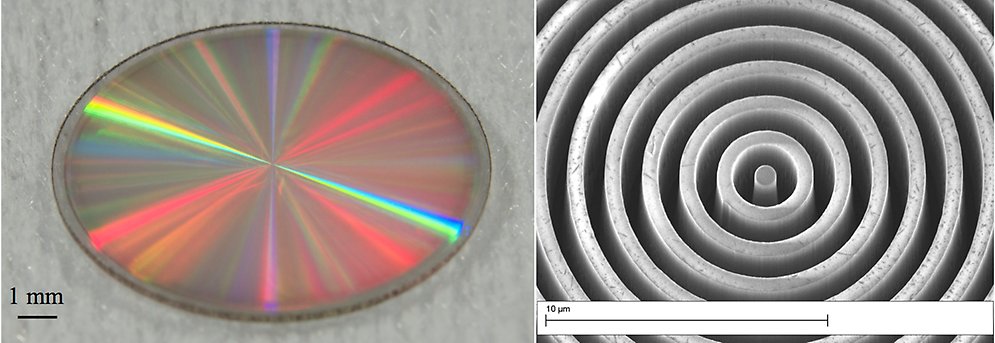Direct imaging of extrasolar planets

(left) Photograph of a K-band diamond AGPM; design wavelength 2.0-2.5 µm. (right) Scanning electron microscope picture of an L-band diamond AGPM; design wavelength 3.4-4.0 µm.
The main goal of this project is to find extrasolar planets through direct detection.
Astronomy and astrophysics
Direct imaging of extrasolar planets
The main goal of this project is to find extrasolar planets by direct detection, which means that one gets access to the photons from the planet.
The combination of the starlight being extremely much brighter than the orbiting planet and that the planet is very close to its host star makes it very difficult to direct image an extrasolar planet. We have therefore during the last 10 years been working on the design and fabrication of a new type of diamond coronagraph, a so-called annular groove phase mask (AGPM).
This coronagraph consists of so called subwavelength gratings, which means that the grating period is shorter than the wavelength. Due to extremely small grating period one can say that the light will not be able to resolve the grating, and we will instead be able to manipulate the polarization of the light (no diffraction at higher orders as with a grating with larger period than the wavelength). This new type of coronagraph, that manipulates the polarization of the light in a special way, is able to block the light from a star without affecting the light of a nearby planet over a wide range of wavelengths. In this way we can say that we are able to hide the star to unveil the hidden planet.
Since this component works at several wavelengths it is also possible to perform spectroscopy of the light from the extrasolar planet, and thus making it possible to look for biosignatures (e.g. habitable planet). Up to now we have been very successful in the design and fabrication of these coronagraphs and several of the components have already been installed in the world leading ground based telescopes; Very Large Telescope in Chile, KECK Observatory in Hawaii and The Large Binocular Telescope in Arizona. The strength of the AGPMs has already been proven by presenting the first image of the brown dwarf called HIP79124 B and by presenting an image of the innermost of three rings of dusty planet-forming material around the young star called HD141569A.
We are currently trying to further improve the design and fabrication techniques of these diamond coronagraphs, and are planning to work against the forthcoming Extremely Large Telescope in Chile.
Another ongoing project is to develop a diamond coronagraph to the Breakthrough Initiative. This coronagraph will be used on the Very Large Telescope, operated by European Sothern Observatory, to search for potential habitable planets in our closest star system – Alpha Centauri. Such planets could be the targets for an eventual launch of miniature space probes by the Breakthrough Starshot initiative.
Collaboration
We have close collaborations with Dr. Olivier Absil and Prof. Serge Habraken at University of Liège (Belgium), Dr. Eric Pantin and Samuel Ronayette at CEA-Saclay (France), Dr. Elsa Huby at Paris Observatory (France), Dr. Markus Kasper at European Southern Observatory (Germany/Chile) and Prof. Dimitri Mawet and Dr. Lorenzo König at California Institute of Technology (USA) and Jet Propulsion Laboratory NASA (USA).
